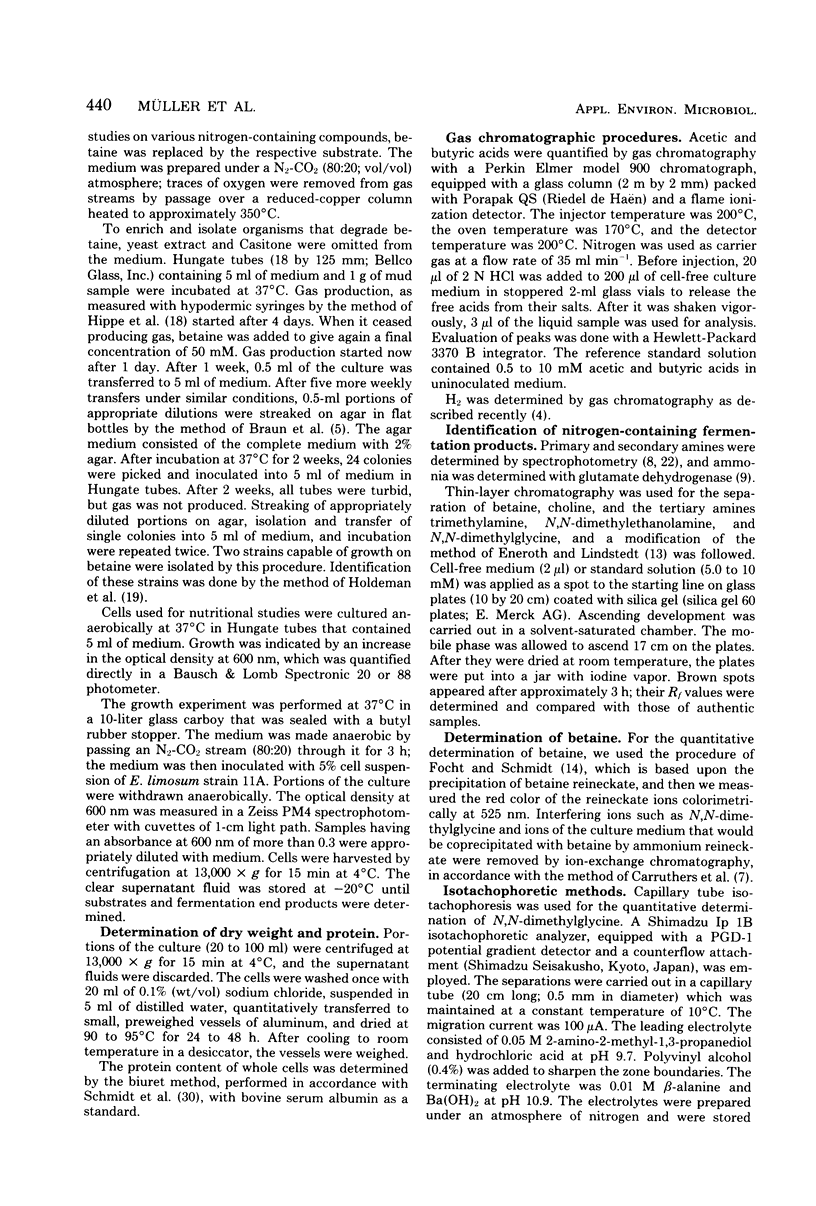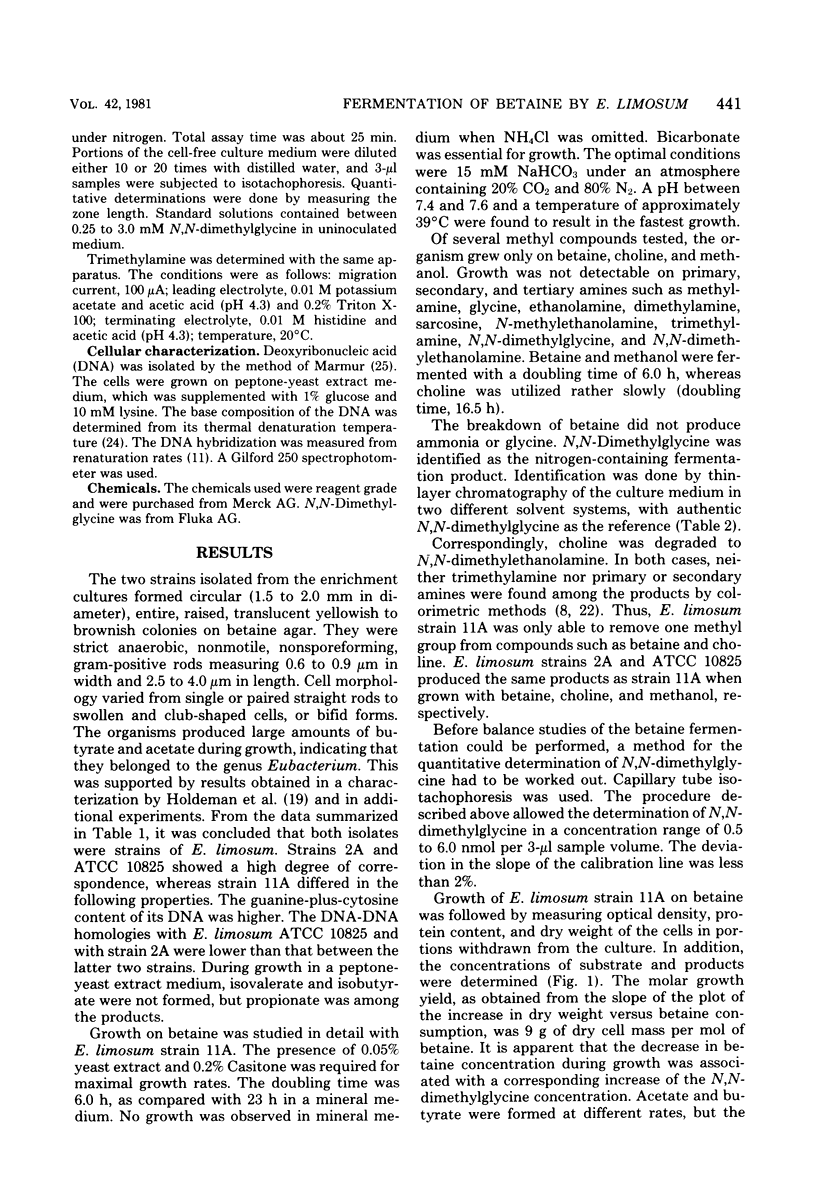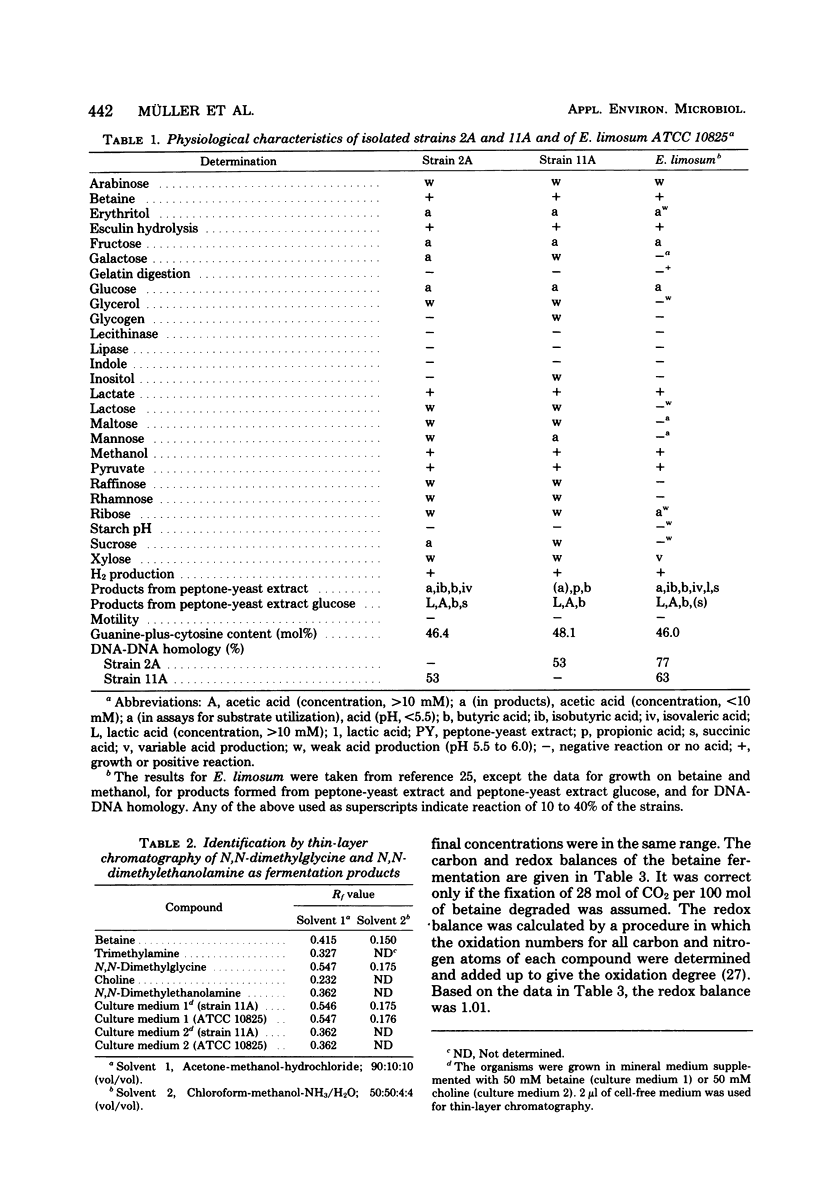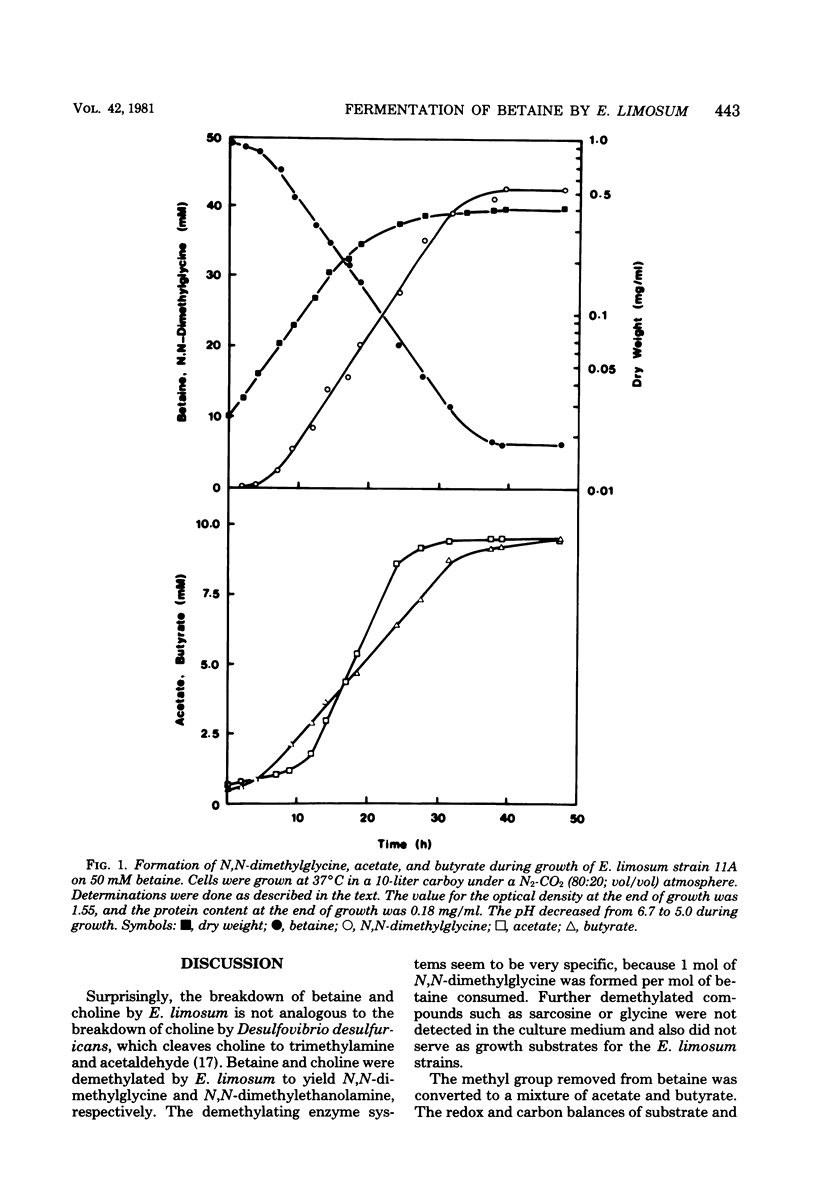Abstract
Two bacterial strains that grow anaerobically on betaine were isolated from enrichment cultures and identified as strains of Eubacterium limosum. In a mineral medium supplemented with yeast extract and Casitone, the doubling time of E. limosum strain 11A on betaine was 6 h at 37°C. The molar growth yield amounted to 9 g of dry cell mass per mol. Betaine was fermented in accordance with the following equation: 7 betaine + 2 CO2 → 7 N,N-dimethylglycine + 1.5 acetate + 1.5 butyrate. E. limosum also grew on methanol and choline. The former was converted to acetate and butyrate, and the latter was converted to N,N-dimethylethanolamine, acetate, and butyrate. The conditions for the quantitative determination of N,N-dimethylglycine by capillary tube isotachophoresis have been determined.
Full text
PDF






Selected References
These references are in PubMed. This may not be the complete list of references from this article.
- AURICH H., ROTZSCH W., STRACK E. ASSIMILATION VON (--)-CARNITIN DURCH PSEUDOMONAS OVALIS. Acta Biol Med Ger. 1963;11:274–280. [PubMed] [Google Scholar]
- Barker H. A., Kamen M. D., Haas V. Carbon Dioxide Utilization in the Synthesis of Acetic and Butyric Acids by Butyribacterium Rettgeri. Proc Natl Acad Sci U S A. 1945 Nov;31(11):355–360. doi: 10.1073/pnas.31.11.355. [DOI] [PMC free article] [PubMed] [Google Scholar]
- Bowlus R. D., Somero G. N. Solute compatibility with enzyme function and structure: rationales for the selection of osmotic agents and end-products of anaerobic metabolism in marine invertebrates. J Exp Zool. 1979 May;208(2):137–151. doi: 10.1002/jez.1402080202. [DOI] [PubMed] [Google Scholar]
- Braun K., Gottschalk G. Effect of molecular hydrogen and carbon dioxide on chemo-organotrophic growth of Acetobacterium woodii and Clostridium aceticum. Arch Microbiol. 1981 Jan;128(3):294–298. doi: 10.1007/BF00422533. [DOI] [PubMed] [Google Scholar]
- Braun M., Schoberth S., Gottschalk G. Enumeration of bacteria forming acetate from H2 and CO2 in anaerobic habitats. Arch Microbiol. 1979 Mar 12;120(3):201–204. doi: 10.1007/BF00423066. [DOI] [PubMed] [Google Scholar]
- Bryant M. P. Commentary on the Hungate technique for culture of anaerobic bacteria. Am J Clin Nutr. 1972 Dec;25(12):1324–1328. doi: 10.1093/ajcn/25.12.1324. [DOI] [PubMed] [Google Scholar]
- De Ley J., Cattoir H., Reynaerts A. The quantitative measurement of DNA hybridization from renaturation rates. Eur J Biochem. 1970 Jan;12(1):133–142. doi: 10.1111/j.1432-1033.1970.tb00830.x. [DOI] [PubMed] [Google Scholar]
- HAYWARD H. R., STADTMAN T. C. Anaerobic degradation of choline. I. Fermentation of choline by an anaerobic, cytochrome-producing bacterium, Vibrio cholinicus n. sp. J Bacteriol. 1959 Oct;78:557–561. doi: 10.1128/jb.78.4.557-561.1959. [DOI] [PMC free article] [PubMed] [Google Scholar]
- Hippe H., Caspari D., Fiebig K., Gottschalk G. Utilization of trimethylamine and other N-methyl compounds for growth and methane formation by Methanosarcina barkeri. Proc Natl Acad Sci U S A. 1979 Jan;76(1):494–498. doi: 10.1073/pnas.76.1.494. [DOI] [PMC free article] [PubMed] [Google Scholar]
- Ikuta S., Matuura K., Imamura S., Misaki H., Horiuti Y. Oxidative pathway of choline to betaine in the soluble fraction prepared from Arthrobacter globiformis. J Biochem. 1977 Jul;82(1):157–163. doi: 10.1093/oxfordjournals.jbchem.a131664. [DOI] [PubMed] [Google Scholar]
- Kortstee G. J. The aerobic decomposition of choline by microorganisms. I. The ability of aerobic organisms, particularly coryneform bacteria, to utilize choline as the sole carbon and nitrogen source. Arch Mikrobiol. 1970;71(3):235–244. [PubMed] [Google Scholar]
- PINE L., BARKER H. A. Tracer experiments on the mechanism of acetate formation from carbon dioxide by Butyribacterium rettgeri. J Bacteriol. 1954 Aug;68(2):216–226. doi: 10.1128/jb.68.2.216-226.1954. [DOI] [PMC free article] [PubMed] [Google Scholar]
- SCHMIDT K., LIAAENJENSEN S., SCHLEGEL H. G. DIE CAROTINOIDE DER THIORHODACEAE. I. OKENON ALS HAUPTEAROTINOID VON CHROMATIUM OKENII PERTY. Arch Mikrobiol. 1963 Aug 1;46:117–126. [PubMed] [Google Scholar]
- STRACK E., NOACK R., AURICH H., FOCKE G., LORENZ I. [Studies on the degradation of carnitine by Pseudomonas pyocyanea A7244]. Acta Biol Med Ger. 1962;9:115–125. [PubMed] [Google Scholar]
- Wolin E. A., Wolfe R. S., Wolin M. J. Viologen dye inhibition of methane formation by Methanobacillus omelianskii. J Bacteriol. 1964 May;87(5):993–998. doi: 10.1128/jb.87.5.993-998.1964. [DOI] [PMC free article] [PubMed] [Google Scholar]


